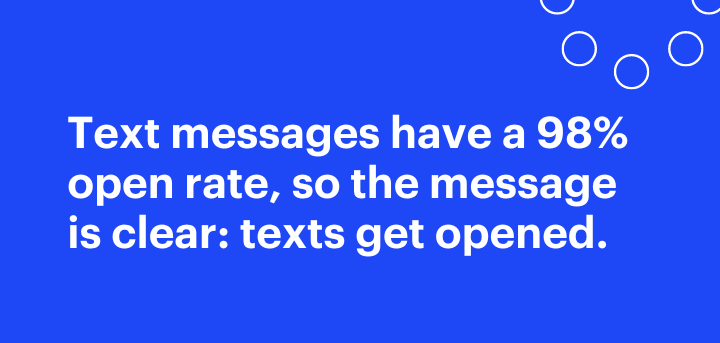Website lead generation is a critical part of any online marketing strategy. And when you’re running a small or local business, it’s even more important to stand out among the crowds of bigger corporations and brands that fill up the search engines. With just a few simple strategies, you’ll turn your website into a lead-generating machine that runs on its own.
1. Make It (Almost Too) Easy To Start a Conversation With You
Conversations with your customers are the cornerstone of building and maintaining customer relationships. They help build rapport, drive engagement, and soothe potential friction points along the purchase journey. The digital world has made conversations feel a little more robotic and a lot less human. Between AI chatbots and automated greetings, the availability of messaging technologies is vast while the presence of human involvement is, oftentimes, quite low or entirely hands-off.
While that may bode well for efficiency, the customer (and very human) relationship suffers, and trust could begin to wane.
You need to distinguish yourself from the digital crowd and catch their questions while they’re still browsing. Here are some ways to include a quick, simple pathway to getting in touch with a real human:
→Create a page dedicated to contacting your business. Businesses commonly use a contact form, which is a helpful way of collecting detailed messages from leads who may need more space to explain their question or circumstances. Include any active social media links as well, since those channels tend to get a lot of organic traffic. (Just make sure you have team members monitoring messages there.)
→Include a (highly visible) button to schedule time with you. Whether you add a button to your main menu or include it in the top half of your home page, you’ll want to make sure that the call-to-action is crystal clear. By the time someone wants to schedule time with you, they’re pretty keen on what your business could provide them, so keep that scheduling process seamless by sending confirmation and reminder messages.
→Try a chat-to-text tool to make conservations more convenient for them. Have you ever been messaging a live chatbot and accidentally clicked out of the window? Or navigated to a new page and lost the original conversation? With chat-to-text, you wouldn’t have to worry about that. Customers can submit a message with their name and number, and carry on with their tasks, knowing the business will text them as soon as possible. Having a text conversation is much more convenient for both parties involved since it’s no longer tied to your website. Plus, compared to email, text messages have a 98% open rate, so the message is clear: texts get opened.

2. Then, Keep The Conversation Going With Incentives
It can be difficult to keep a conversation going once it has started to fizzle out. The key to re-engaging past or yet-to-purchase customers is providing added value to what’s already presented on your website. Or what they’ve already experienced with your team in their conversations. You need to provide a reason for them to keep coming back. Give them something else to pay attention to. Yes, we’re talking about incentives here.
You’ve probably seen them everywhere: the website pop-ups that ask for your email address or phone number in exchange for a discount on your first purchase.
You know why you see them everywhere? Because they really do work. With the short amount of time someone is willing or able to spend browsing your site, you should be giving them a reason to stay engaged. Signing up for promotional content enables them to remember why they sought your business in the first place. By sending them promos via email or text (tip: the latter has a 98% open rate, so we’d suggest going with that), you’re crafting the narrative of why your offerings bring the most and best value.
Enticing marketing incentives could include a discount on their first purchase, free shipping, a discounted or free consultation, or even a downloadable freebie (i.e. PDF that’s emailed or texted to them following the sign-up). By including an offer as a thank you for their sign-up, your business is beginning to build relationships that will carry on long after they leave your site.

3. Amaze Them With Original Content
Okay, amaze might be a little strong, but let’s definitely catch their attention for a hot minute. Or more. People are most drawn to novel and stimulating content, and while some businesses might assume content of that sort is unavailable or irrelevant to them, they’re missing out on a golden opportunity: making content their way for their ideal customers.
When compiling a content strategy, it may help to consider how you would convey your value to the busiest person in the world. Make it simple, concise, and easily visible before scrolling or clicking anywhere else.
→Prioritize professional photoshoots for any content that’s going live on your website, especially your home page. It’s not breaking news that compelling, high-quality images are effective attention-grabbers. When someone opens your site, they’re unlikely to have the time or interest in reading a long paragraph or several strings of text, even if it’s the most compelling copy you’ve ever published. The cliche is true: pictures are worth much more than words.
→More so than ever, videos are all the rage online. They convert higher than standalone images and provide much more freedom to express your brand your way. Whether that’s an intro video to your latest product launch or a sentimental story of how your business came to be, your visuo-audio content is a major key to online lead generation.
→Blogs aren’t going anywhere. Starting and maintaining a company blog is an effective way to provide and promote your value to both potential and existing customers. You can control what content you post, when you post, and where it lives on your site (tip: dedicate a tab to your blog in your main navigation and provide entry points on your home page). Curating original online content has a two-fold advantage: It’ll boost your organic SEO by implementing industry buzzwords and addressing high-traffic consumer subjects; And it’ll allow all new visitors to know that you have much more to offer than just selling them something, which ultimately strengthens trust and consumer engagement. People are sure to keep coming back for more.
4. Build Trust With Reviews and Testimonials
Think about who you trust the most: family, close friends, and perhaps some experts here and there. That’s exactly how your customer is going to think when considering your business to support. And that’s where testimonials become the key turning point from website visitor to repeat customer.
By providing (honest) reviews from people who loved your products or services, you’re essentially empowering potential leads to see themselves in those success stories. Your best advocates are your happiest customers, so inviting them into your brand’s story is an incredibly powerful way to grow your audience, both online and in-store.
If you’re still working on gathering reviews and testimonials, try reaching out to happy customers and politely inviting them to review your business (tools like Podium can make this easy). You can use the star ratings as well as any open-ended praise to showcase on your website’s home page or commerce pages.
It might sound like an intimidating process to build up your review feed, but it’s a worthy investment. And don’t underestimate how much customers are excited to support small and local businesses. When established early on, trust can ultimately maintain and strengthen relationships for years (and transactions) to come.
5. Make Sure You’re Mobile-Friendly
Everyone (and their grandparents) are on smartphones now. In this evermore-busying world, we have to stay in touch to stay safe, aware, and let’s face it, sane. With these small computers in our back pockets, you’re closer than ever to potential customers and clients—right at their fingertips, actually.
→Keep your page scrolls manageable. Be wary of really long pages, especially when it comes to your home page. If someone can’t figure out what value you provide within 3 – 5 seconds of landing on your site, bump up your most compelling copy to the top and cut your scroll time.
→Be sure your designs are responsive. Layouts usually have to dramatically change to fit mobile dimensions. Features like buttons, pictures, and animations end up rendering quite differently (see: sometimes badly) on phones. Responsiveness is especially critical for navigation, and with mobile experiences prioritizing quick actions, you’ll want to make sure people can get around your site without friction.
→Make the call-to-action clear. Along with a responsive design, a clear action is equally as important to capture people’s attention within—yes, you guessed it—3 – 5 seconds. Whether your key value is buying your products, scheduling a consultation, or signing up for marketing texts, you should float that value to the top of the home screen, especially on your mobile layouts, in the form of a button or banner.
Some Final Thoughts
Early in the customer journey, there are several opportunities to win favor and support. Those first impressions matter, and your website is the medium through which you can master them. Whether someone finds you on social media, through a friend, or walking past your storefront, they’ll want to learn more, and you know what they’ll do first? Look you up online. Time to make it well worth their while.




